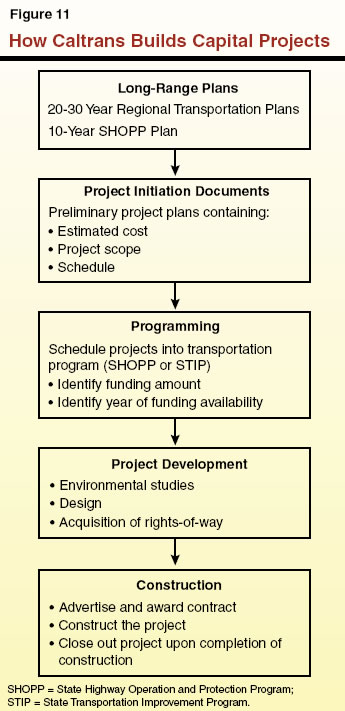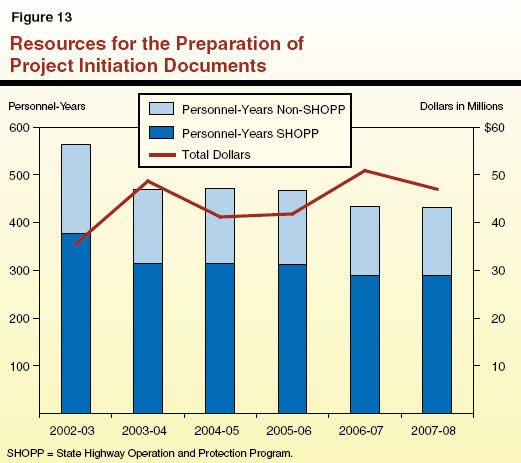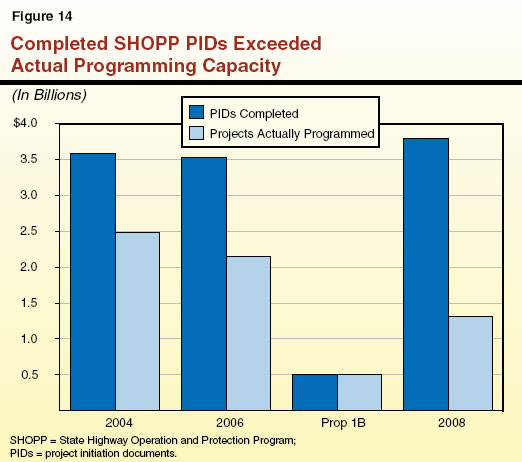2009-10 Budget Analysis Series: Transportation
Caltrans’ transportation planning program is responsible for a range of activities including the preparation of initial plans for individual projects, also called “project initiation documents” (PIDs). Caltrans proposes to allocate $51 million (SHA) and 433 personnel–years (PYs) for the preparation of PIDs in the budget year. This compares to $49 million and 433 PYs provided for the department’s PID activities in 2008–09. In this section, we examine Caltrans’ PID activities and make recommendations to improve the allocation of resources for this program activity.
How Caltrans Plans Highway Capital Projects
Project Ideas Come From Long–Range Plans. Figure 11 shows the steps the state takes to plan, develop, and build highway capital projects. As shown in the figure, long–range transportation plans forecast travel demand over a period of many years and identify alternatives, including various capital improvement projects that would meet the projected travel demand. These plans are fiscally unconstrained, meaning that the potential capital projects are identified in the plans without regard to funding availability. Current law requires Caltrans to plan for long–term rehabilitation, major repairs, and reconstruction of the state’s highways in the Ten–Year State Highway Operation and Protection Plan. Long–range plans for highway expansion, development of transit systems, and local street and road improvements, called Regional Transportation Plans (RTPs), are developed by regional transportation planning agencies. The RTPs typically cover a period of 20 to 30 years.

PIDs Provide Details About Individual Projects. Project ideas are identified in the long–range plans. Before potential projects can be developed and constructed, however, detailed project planning work must first be completed. Initial project plans, called PIDs, contain specific information, including the identification of the transportation problem that is to be addressed, an evaluation of potential alternatives to address the problem, and the justification and description of the preferred solution. Each PID also includes the estimated cost, scope, and schedule of the project—information needed to decide if, how, and when to fund the project.
PIDs Required Before Projects Can Be Programmed for Funding. The CTC requires that a PID be completed before a project can be adopted into one of the state’s transportation programs, and state funding scheduled for the various phases of a project (such as environmental review, design and construction). The state has two main ongoing transportation programs, SHOPP and STIP. The SHOPP is a four–year program of projects that rehabilitate the highway system, or improve the system’s safety. The STIP is a five–year program for expanding the capacity of state highways. Both SHOPP and STIP are updated in two–year cycles.
Projects that are to be programmed in an upcoming cycle must have PIDs prepared and completed before the cycle begins. Thus, as Figure 12 shows, PIDs are typically prepared during the two–year period between programming cycles. For example, PIDs for projects that are to be programmed into the 2010 SHOPP would ordinarily be prepared during 2008–09 and 2009–10. The amount of work and length of time needed to complete a PID depends upon the complexity of the project. A PID for a relatively simple project such as a SHOPP pavement project typically takes a few months, while a PID for a more complex project, such as a STIP project to significantly expand a highway, may take a few years to prepare. In dollar terms, the cost to produce a single PID can range from tens of thousands of dollars up to a few million dollars.
Figure 12
SHOPP Programming Cycles and PIDs |
2006‑07 |
2007‑08 |
2008‑09 |
2009‑10 |
2010‑11 |
2011‑12 |
2012‑13
And Beyond |
2006 SHOPP |
|
|
|
|
|
|
Year 1 |
Year 2 |
Year 3 |
Year 4 |
|
|
|
|
|
2008 SHOPP |
|
|
|
|
PIDs developed for 2008 SHOPP |
Year 1 |
Year 2 |
Year 3 |
Year 4 |
|
|
|
|
|
2010 SHOPP |
|
|
|
|
PIDs developed for 2010 SHOPP |
Year 1 |
Year 2 |
|
|
|
|
|
|
|
2012 SHOPP |
|
|
|
|
PIDs developed for 2012 SHOPP |
|
|
SHOPP = State Highway Operation and Protection Program; PIDs = project initiation documents. |
After a PID is completed it is put on the “PID shelf” until funding becomes available in the next programming cycle. (Caltrans defines the PID shelf as planning documents that have been completed for projects that have not been programmed.) However, when there are more PIDs completed than can be funded, some PIDs could remain on the shelf for a number of years.
Most PIDs Are Prepared by Caltrans Staff. All PIDs for potential SHOPP projects, and many PIDs for potential STIP highway projects, are prepared by Caltrans staff who are mainly engineers and transportation planners working in district offices throughout the state. (Some PIDs for STIP projects are prepared by regional agencies.) Figure 13 shows the number of PYs and funding expended on the preparation of PIDs from 2002–03 to 2007–08. As the figure shows, staffing (in PYs) for PID activities has declined somewhat since 2002–03, while total expenditures to support those staff have increased slightly in that time. However, since 2006–07, staffing has been stable at about 430 PYs. In total, from 2002–03 to 2007–08, the department spent about $265 million preparing PIDs.

PIDs Completed for Many Projects That Cannot Be Funded
Having Some PIDs on the Shelf Is Warranted. At the time PIDs are prepared, it is not possible for Caltrans to know exactly how much funding would be available to program new projects for development. Because of this uncertainty, it is reasonable for Caltrans to have some PIDs on the shelf at any given time. In addition, if new funding unexpectedly becomes available, as could happen with federal economic stimulus funding for transportation projects, having some PIDs already completed could allow projects to start more quickly than would otherwise be possible. However, this benefit would be limited because projects on the PID shelf still require project development (such as environmental review, engineering, design, and acquisition of rights–of–way). Consequently, only a few projects with completed PIDs would likely be able to start construction quickly enough to qualify for federal stimulus funding.
Many More SHOPP PIDs Prepared Than Needed. Our review shows, however, that the amount of new PIDs produced for each SHOPP cycle far exceeds the funding available to develop and construct new projects. Figure 14 compares the dollar value of projects for which SHOPP PIDs have been completed to the dollar value of new projects actually programmed in the recent three SHOPP cycles and for the Proposition 1B program. As the figure shows, funding available to add new projects to SHOPP has declined in recent programming cycles; however, Caltrans’ production of PIDs during this time has increased.

Caltrans Has a Large Shelf of PIDs for Unfunded SHOPP Projects… The over–production of SHOPP PIDs has led to a large number of PIDs sitting on the shelf. As of July 2008, Caltrans had 485 completed PIDs for unfunded SHOPP projects. The amount of funding needed to develop and construct all these projects is estimated to be $4.7 billion. By comparison, when the SHOPP was updated in 2008, only 196 new projects with a combined development and construction cost of $1.3 billion were actually funded. At this rate, it would take at least three programming cycles (more than six years), to program the entire shelf of SHOPP PIDs, assuming that no additional PIDs were completed. Having a $4.7 billion shelf of projects is excessive, in our view, because it is unlikely that there will be sufficient funding for a number of these projects.
…And a Large Shelf of PIDs for Unfunded STIP Projects. As of June 2008, there were 84 STIP projects for which Caltrans had completed PIDs. (This does not include additional PIDs completed by private consultants and paid for by regional transportation agencies). Caltrans estimates that it would take about $16.7 billion to develop and construct these 84 projects. By comparison, the STIP is currently being funded at the rate of about $700 million worth of highway projects each year. At this rate it would take more than 23 years before sufficient funding would be available to program all of the STIP projects with completed PIDs, assuming that no additional PIDs were completed. While some of these projects may ultimately be funded with local funds rather than with state funds, we believe having $16.7 billion worth of shelf projects is excessive given the state’s transportation funding outlook.
Having Such a Large Shelf of PIDs Is Inefficient. Once a PID is completed most of the information is typically current and therefore useable for about two years. After that time, additional work is often required to update the document before a project can be programmed for funding. Some information in PIDs, cost estimates in particular, become outdated even more quickly. Cost estimates typically need to be updated after about six months. For instance, if a project is not programmed for development within a couple of years, the initial estimates would likely be no longer useable due to inflation or other changes in market conditions.
Other factors could make the information in a PID out of date as well. For example, a PID may identify a certain preferred alignment for a project; however, over time, the property needed for that alignment may not be available due to development. When a substantial amount of information in a PID is outdated, Caltrans must dedicate additional resources to revise or redo the document. Additionally, to the extent some PIDs will never be developed or constructed into projects due to funding constraints, the resources being spent on their preparation are wasted.
Recommendation: Reduce Staffing For Project Planning in 2009–10
Continued Staffing at Current Level Not Justified. In light of the large shelf of PIDs that currently exists, the department’s request for 433 PYs and $51 million to prepare PIDs in 2009–10 is not justified. The requested level of resources is essentially the same as Caltrans has received for the past three years, which has led to an over–production of PIDs, as discussed earlier. Furthermore, Caltrans is not able to justify the requested staffing level on a workload basis. Specifically, it cannot identify projects that are high in priority for future funding but for which a PID is not completed. Absent such workload justification, continuing to staff PID preparation at the current level would only result in a larger shelf of PIDs mainly for projects that would not proceed for many years.
Some Resources Needed in 2009–10 to Prepare Essential PIDs. Despite having many completed PIDs on the shelf, our analysis indicates that the department will nonetheless need some staff to prepare PIDs in 2009–10. This is because the department typically has workload related to unexpected events, such as emergencies and safety hazards. Additionally, staff would be needed to continue and complete work on PIDs for projects for which funding has been committed in 2009–10 from non–state sources, such as local sales tax revenues.
Staffing for PID Work in 2009–10 Should Be Reduced Substantially. Given the large shelf of PIDs, we recommend that the Legislature substantially reduce the funding and staffing allocated to PID activities for 2009–10. Because the department is not able to provide PID workload information, we cannot identify a precise level of staffing that should be provided; however, we estimate that roughly one–fourth of the current staffing (about 100 PYs) would be sufficient to cover any unexpected workload and complete outstanding PIDs in 2009–10. Accordingly, we recommend that the department’s request be reduced by 330 PYs and $40 million from SHA. Because the staff (mainly engineers and planners) that prepare PIDs could easily be shifted to perform other work within the department, reducing PID staffing would not require laying off any workers. Instead, we think this reduction could be achieved by shifting them to vacant positions among Caltrans’ approximately 9,000 other engineering and planning staff.
Recommendation: Base Staffing on Workload Beginning in 2010–11
Staffing Does Not Align With Workload Needs. In order to manage its PID workload well, Caltrans should regularly assess how many PIDs it needs to be preparing at any given time to facilitate the programming of projects. This assessment should also include monitoring of the status and completion of documents after work on them is started. However, the department is unable to demonstrate that it has such workload information. Absent this information, Caltrans is unable to estimate the staffing needs for the preparation of PIDs. Instead, as discussed above, Caltrans has allocated a steady level of staffing for PID preparation in recent years, even though more PIDs were prepared statewide than were actually needed.
Our review also found that, at the district level, the allocation of staffing for PID work does not match up with each district’s actual PID workload. Rather, staff are allocated to the districts based on a formula of past staffing expenditures on PID work and highway lane miles in each district. As districts’ workload varies from year to year, this method results in too many staff being provided to some districts and not enough to others. For instance, some projects with committed local funding could be held up because a district does not have adequate staff to prepare PIDs. In other districts, Caltrans staff could be preparing PIDs for projects that may not be funded for many years.
Staffing for PID Activities Should Be Based on Workload. Based upon our analysis, we believe that Caltrans should substantiate its PID staffing request each year by identifying the volume and types of projects for which PID work needs to continue or be initiated. This approach would (1) better match staffing with program needs at both the statewide and district level, and (2) facilitate legislative oversight of the department’s PID activities, thereby improving accountability.
The approach we propose would also be consistent with the way the department currently budgets for capital outlay support—that is, the staff needed to do environmental review, design, engineering, and oversight of the construction of projects. Accordingly, we recommend the Legislature adopt budget bill language directing the department to determine its ongoing staffing for PID activities based on workload, beginning in 2010–11.
Recommendation: Improve Management of PID Activities
Significant Gaps in Determining and Managing PID Work. In addition to the lack of workload information described above, our review found other gaps in Caltrans’ determination and management of PID activities. Specifically, the department should have (1) criteria it uses to determine the SHOPP projects for which PIDs should be prepared, and (2) information about the viability of the projects on the PID shelf (including whether a project is still the appropriate solution to address a transportation problem, or whether funding is still available for the planned project). Our review, however, finds that there are problems in each of these areas.
- No Criteria for Selecting SHOPP PIDs. The department was unable to demonstrate that it has standard criteria for selecting SHOPP projects for which PIDs would be developed. (Regional transportation agencies determine the choice of most STIP PIDs.) Discussions with district offices indicate that districts use different methods to select projects for PID preparation, ranging from district priorities to complaints by the public about highway conditions and facilities. This could lead to the preparation of PIDs for projects that are not a high statewide priority and, thus, that are unlikely to be programmed later for funding.
- Viability of Projects on PID Shelf Is Unknown. As noted earlier, Caltrans has 569 completed PIDs on the shelf. However, Caltrans apparently does not track whether and when these projects would likely be funded and if they are still viable projects. If they are, the department may need to allocate resources to update the respective PIDs. Conversely, if some of the projects are no longer a priority, then PIDs for different projects might be a more important priority. However, because it apparently does not track the status of these projects, Caltrans is unable to effectively manage its PID workload.
Assess Project Viability and Set Criteria for PIDs for SHOPP Projects. In order to determine the staffing it needs for its PID workload, the department should (1) assess the PIDs that are on the shelf to determine if the projects are still viable, and (2) set criteria to select the SHOPP projects for which PIDs should be prepared. These requirements should apply beginning with the preparation of the department’s 2010–11 budget. To ensure that the department carries out these two tasks, we recommend that the Legislature adopt supplemental report language requiring Caltrans to report to the Legislature on these efforts.
Return to Transportation Table of Contents, 2009-10 Budget Analysis SeriesReturn to Full Table of Contents, 2009-10 Budget Analysis Series